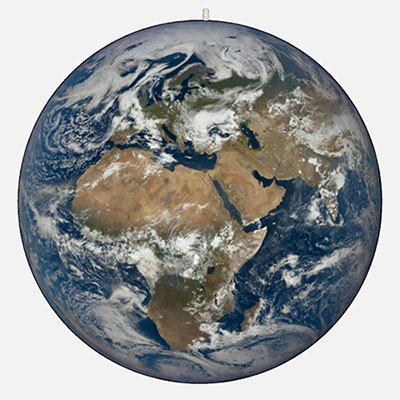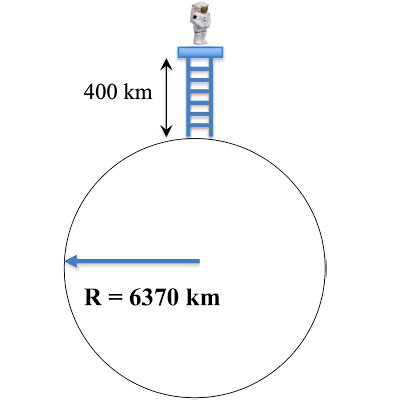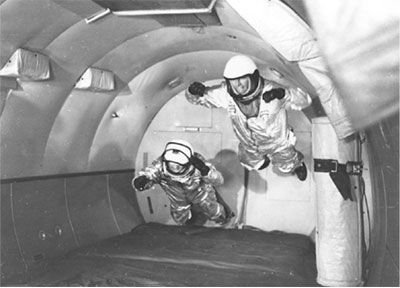Teaching Free Fall in the Classroom
In preparation for his Zero-G flight, Dan Burns revisited some of his go-to activities for teaching free fall in the classroom. Now he's sharing his tips and tricks for tackling student misconceptions
Free fall is frequently misunderstood, and I put a lot of effort into helping my students understand it during my physics teaching career. Since then, I’ve continued to refine my methods as the Physics Curriculum and Training Developer for PASCO scientific. In this blog, I’ll share some of my favorite approaches for teaching about free fall and explain students’ most common misconceptions.
My aerospace engineering expertise was in astrodynamics, sometimes called orbit mechanics. It is the study of the path of objects in space. When I first became a high school physics teacher, I was excited to teach about it, but I quickly encountered powerful misconceptions that acted as barriers to student understanding.
Are the Laws of Physics Different in Space?
One misconception is that the laws of physics in space are different from those on Earth. Students often think gravity turns off once you enter space. To help them overcome this, I put a 400-km-tall ladder on a globe of Earth. I make its height to scale with a 12" diameter globe, which scales to a height of about 3/8". 400 km is approximately the orbital altitude of the International Space Station (ISS). Students are usually surprised to see how short the ladder is. Does it make sense for the gravitational pull of the Earth to drop to zero after moving such a short distance away? Most students start to question their beliefs from this simple visual aid.

Misinterpretations of the Term Free Fall
Free fall is a loaded term for students because they think of each term separately. Some assume "free" means there are no forces acting. Some think "fall" only describes something getting closer to the ground. It is important to make sure they understand that when used together, the words “free fall” represent a motion that’s only under the influence of gravitational forces. It can be moving toward or away from the ground. An object in free fall at the highest point of its motion or in a circular orbit is doing neither.
Astronaut on a Ladder Example
Imagine a space-suited astronaut climbing the ladder into space. What would the astronaut observe if they stood at the top of the ladder on a scale? I would then calculate the gravitational force acting on the astronaut at the top and bottom. The top would be 88% of the surface value. This would be measurable but hardly noticeable. The astronaut might be very disappointed after expecting the scale to read zero.
What would happen if they dropped a screwdriver from the top of the ladder? Would it float? No! It would fall straight down. The astronaut is doubly disappointed. They’ve dreamed about floating in space all their life. They’ve finally climbed a 400-km-tall ladder, and things are essentially the same, save for the lack of atmosphere. How could they see the screwdriver float? Usually, at least one student will figure this out. The astronaut should drop the screwdriver after jumping off the ladder. From the falling astronaut’s perspective, the screwdriver would appear to be floating. The astronaut could finally achieve their dream of floating in space! But for how long? After a few minutes, they will encounter the atmosphere at rapid speed, and that won’t end well if their only protection is a spacesuit!
Students can use kinematics or energy conservation to determine the astronaut's speed as they encounter the atmosphere. Assuming g is constant gives a reasonable answer, but you can also use Ug = -GMm/r for gravitational potential energy.
So how can the astronaut experience free fall in space without fizzling into the atmosphere? Is there a way to prolong their free fall? I pose this question after displaying an image that is not drawn to scale. This makes it more likely that students will share their ideas.

If the astronaut ran and jumped, the Earth would curve away as they fell. This would prolong their time in free fall. If they could run fast enough, they’d avoid hitting the Earth and fall all the way around! To be in orbit, the astronaut must be moving sideways with a velocity so high that their path doesn't intersect the Earth. To complete an orbit, they must be above the bulk of the atmosphere.
If the astronaut releases the screwdriver after running and jumping, it will fall with them as they circle the Earth, creating the appearance of floating. Returning to our scaled model of the ladder on Earth makes it clear that the astronaut will need to move sideways unbelievably fast! This is clearly too fast to run (unless you can run faster than a bullet). Rockets are the only technology that can accelerate an object the size of an astronaut or spacecraft to the required speed. Although most rockets launch vertically, they soon pitch over, adding most of the velocity in a direction parallel to the Earth's surface.
Clicker Check
Now that we have established that objects appear to float in space only if they are in free fall together, I put up this clicker question:
An astronaut lets go of a screwdriver while orbiting the Earth. It floats before her eyes. The same thing can be done:
A. In an airplane
B. On an amusement park ride
C. In a high school classroom
D. All of the above
E. None of the above
Student answers are usually well distributed. Not because they didn't understand the previous discussion, but because few students think C can be correct. Some have heard about airplanes that fly parabolic arcs, and some have ridden free fall rides at amusement parks. They don’t believe it can be done in an ordinary classroom, so they are confused by the other choices. After letting them discuss their answers with their peers and re-voting, a few switch to D but most stick with their original answer.
At this point, I pick up a screwdriver, get on a stool and jump while releasing the screwdriver in front of my face. For a fraction of a second, it floats in front of my eyes. The only difference between my experience and the astronaut's experience is the duration. How could I increase the duration? I can jump up and release the screwdriver. Then, we are in free fall together on the way up and on the way down. If I could jump as high as the stool, I would double the duration. I encourage students to try it themselves using something softer than a screwdriver. Though they’re not necessary, small trampolines are perfect for seeing objects float with you on the way up and down. Just release the object after losing contact with the fabric.
Zero-g Experiences on Earth
Amusement Park Rides
Can the duration of free fall on Earth be increased further? Amusement park rides have braking systems that allow free fall to occur for up to about 3.5 seconds on the way down. The Superman ride in Southern California's Magic Mountain launches riders horizontally at about 100 mph. The track curves up, so riders are in free fall for about 3.2 s on the way up and 3.2 s on the way down. I have ridden it several times but prefer the Drop Tower at Santa Clara's Great America Park for experiencing free fall. The Drop Tower releases riders from rest for about 3.5 s of free fall. Technically, this isn't quite right because free fall is the motion of an object acted on only by gravitational forces. Ride cars are heavy, and at some point, air resistance reduces the acceleration. Nonetheless, riders travel at 35 m/s near the end of the drop. That is almost 80 mph!
NASA’s Zero-G Research Facility
The Zero G Research Facility at the Glenn Research Center has a 132 m evacuated drop tower that allows for 5.18 s of true free fall. Although it’s large enough to hold a person, I wouldn’t recommend trying it unless you’re immune to the 65 g peak acceleration at the end. NASA does a lot of experiments using this facility. It’s also used to test equipment on Earth before sending it into orbit. There are many research questions that can be answered in 5.18 s. You can see the inside of the Zero Gravity facility in this short video.
Free Fall in an Airplane: Flying Parabolas
When experiments require a longer duration free fall, researchers use another option. Instead of getting rid of the air, additional forces can be applied to the object. If they have a sum that is equal in magnitude and opposite in direction to air resistance, then the object will move like it is in free fall.
These forces can be supplied by an airplane using the lift of the wings and the thrust of the jet engines. The airplane can also use these forces to pull up at the end of the free fall to avoid hitting the ground. This technique was first suggested in 1950 by German rocket scientists, Fritz and Heinz Haber. The paper they authored while working for the US government as part of Operation Paperclip makes for a fascinating short read.
Scott Crossfield and Chuck Yeager were the first to attempt this airplane technique for an extended duration in 1951. Both reported signs of disorientation during the 20 seconds of free fall.
Eventually, NASA configured a C-131B cargo plane to fly parabolic trajectories so that experiments could be conducted in a volume larger than a jet cockpit. Like Scott and Chuck, NASA passengers were often disorientated by the flights. Flying parabolas can wreak havoc on a passenger's inner ear due to the many periods of downward acceleration during free fall and upward acceleration while pulling up. This led to the plane's nickname, Vomit Comet.

Technically, the plane is not in free fall during these flights, but the people and objects inside are. The plane has forces acting on it in addition to gravitational forces, but they add up to zero. If a person tried the same thing using a jet pack, they would not feel like they were floating. They would feel a squeezing sensation caused by the force of air resistance on one side and the push of the jet pack engine on the other. During a parabolic arc, the plane rotates through about 90 degrees. This produces a small centripetal acceleration on objects attached to the plane, which increases with distance from the center of rotation. It is below the accelerations caused by vibration.
Zero-G Terminology
The words used to describe the experience of free fall can be misleading. NASA originally used the term "zero gravity,” which naturally led people to believe there isn’t any gravitational force in space. Ideally, those using this term would say, "It is as if there is no gravity.” Unfortunately, this is seldom done. We may be stuck with this term, but all is not lost for physics teachers!
Why Gravity is Not a Force
According to Einstein's equivalence principle, there is no difference between being in free fall and being in a place where there is no gravity. From this perspective, gravity is not a force; it is the curvature of spacetime. Objects will follow this curvature unless they are acted on by forces. A person in free fall is not accelerating. A person at rest on the surface of the Earth is accelerating up at 9.8 m/s2 or 1 g. This is an interesting and valid perspective, but it might be counter-productive in an introductory physics course. I will assume there are gravitational forces for the remainder of this post. For those who are curious, Veritasium's video, "Why Gravity is NOT a Force" provides a good introduction to this other way of thinking.
Zero-G or Zero-g?
Another problematic term used to describe free fall is zero-G or zero-g. G is the universal gravitational constant, and g is the acceleration due to gravity. If either were zero, the gravitational force would be zero. As far as I can tell, these terms are used interchangeably.
The term "zero-g" is more commonly used by NASA and other space researchers. Those using "zero-G" appear to be doing so for aesthetics, like the Zero-G company that flies a parabolic arc plane for paying customers (and occasionally PASCO employees like me). g is sometimes used as a unit of acceleration where 1 g = 9.8 m/s2. However, if you use an accelerometer to measure acceleration you will discover something surprising. In free fall, the reading will be 0 m/s2 or 0 g. If it is at rest, it will measure the vertical acceleration to be upward at 9.8 m/s2. Toss it into the air, and it will measure more than 1 g as your hand speeds it up and catches it. It can be fun to let students discover this on their own if you have accelerometers in your lab.
What is Weightlessness?
The term weightlessness is used to describe free fall. Weight is an imprecise term in physics. Most textbooks define it as the gravitational force acting on an object, but some define it as whatever a scale reads. The latter definition is more common outside the USA. I recommend introducing your students to both definitions and making it clear which one you will use.
In the scale definition, weightlessness is an accurate term for free fall because the scale would read zero in free fall. But if weight is the gravitational force on an object, weightlessness is not an accurate term. There is a gravitational force acting on an object in free fall. A better term would be apparent weightlessness. This is sometimes used, but it begs the question: why not describe what it is rather than what it appears to be? An object in free fall has no supporting force acting on it. For a person standing on the floor, the supporting force is the push of the floor on their feet. This force is called the normal force.
If the person is in free fall, the normal force is no longer acting on them. Instead of weightlessness, why not name it for the force that is missing? It should be called normalforcelessness. As far as I know, I first coined this term in the 1990s. I have promoted normalforcelessness to my students for decades. I even had a colleague write a page in Wikipedia about normalforcelessness, but it was removed after a few years because the term hadn’t been used in any peer-reviewed papers. Since then, I’ve asked my students to include normalforcelessness in any paper they submit for peer review. None have done it yet, but some have promoted it in other ways online. Search "normalforcelessness" online and every reference will have originated from my students’ efforts.
Did we say zero gravity? We meant microgravity!
In the 1970s, NASA began using microgravity to describe free fall. While there’s a chance NASA’s desire to ditch the zero-gravity terminology contributed to the change, it’s more likely to have been intended for researchers who were looking to experiment with free fall.
Free fall spacecraft and research facilities exhibit small deviations from pure free fall. A pivoting solar array, circulating cooling fluid, an exercising astronaut, or drag in low-Earth orbit can produce tiny forces that cause micro-accelerations. Even solar radiation can cause measurable acceleration on a high-altitude spacecraft. Some experiments are more sensitive to these deviations than others. Scientists often use free fall facilities to determine how far from 9.8 m/s2 the free fall will be, so they can interpret the results of their experiments.
After going through these terms with my students, we watch a short clip from the old CNN show, Science and Technology Week featuring Miles O'Brien. The video follows Miles as he flies with undergraduate students on the Vomit Comet and discusses free fall.
What Happens if You Try Classroom Physics on a Zero-G Flight?
As someone who’s dreamed about space since childhood, I’ve spent most of my life hoping for my chance to float through space. If you’re a physics teacher, we’ve probably pondered many of the same questions: What does it feel like? How would my classroom setups respond to extended free fall? How prone to motion sickness am I?
We recently teamed up with former physics educator, Deb Houts, and the Zero-G company to help revive their teacher flight program. In November 2021, I joined Deb aboard the Z-Force One plane for my first research flight and got amazing results. I wrote about the whole experience and included links to my flight data here.
